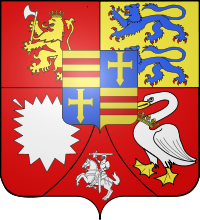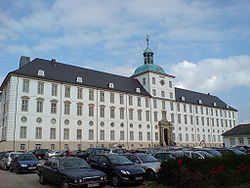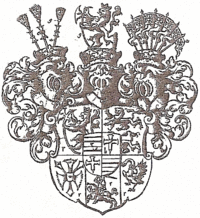- Dukes of Holstein-Gottorp
-
Main articles: History of Schleswig-Holstein and List of rulers of Schleswig-Holstein
Holstein-Gottorp or Schleswig-Holstein-Gottorp is the historiographical name, as well as contemporary shorthand name, for the parts of the duchies of Schleswig and Holstein that were ruled by the dukes of Schleswig-Holstein-Gottorp. Other parts of the duchies were ruled by the kings of Denmark. The territories of Gottorp are located in present-day Denmark and Germany. The main seat of the dukes was Gottorf Castle in the city of Schleswig in the duchy of Schleswig. It is also the name of the ducal house, which ascended to several thrones. For this reason genealogists and historians sometimes use the name of Holstein-Gottorp for related dynasties of other countries.
The formal title adopted by these rulers was "Duke of Schleswig, Holstein, Dithmarschen and Stormarn", but that title was also used by his kinsmen, the kings of Denmark and their cadet branches, as it was the common property of all these agnates. The Gottorp branch held Landeshoheit (sovereignty) over the duchy of Holstein in the Holy Roman Empire and over the duchy of Schleswig in the kingdom of Denmark.[citation needed] The name Holstein-Gottorp is for the sake of convenience used instead of the technically more correct "Duke of Schleswig and Holstein in/at Gottorp".[citation needed]
The oldest of the ducal titles was that of Schleswig, which had been confirmed in fief to a royal kinsman by [the regent Queen Margaret I of Denmark, Sweden and Norway on behalf of her son Olaf II of Denmark in 1386. The kings of Denmark were granted Holstein as an imperial fief by the Holy Roman Emperor Frederick III from 1474.
Contents
History
 Coat of arms of Holstein-Gottorp
Coat of arms of Holstein-Gottorp
In 1544 the so-called "one-third duchy" was ceded to Adolf, third son of King Frederick I of Denmark and the youngest half-brother of King Christian III of Denmark. Thus the surviving House of Holstein-Gottorp is a cadet branch of the House of Oldenburg. The Dukes of Holstein-Gottorp shared the uneasy rule of Schleswig and Holstein with the Kings of Denmark. As such, they were often allies (practically clients) of the Swedes, enemies of the Danes. This longtime alliance was sealed by several dynastic marriages: Christina of Holstein-Gottorp married Charles IX of Sweden, Hedwig Eleonora of Holstein-Gottorp married Charles X Gustavus, Duke Frederick IV married the eldest daughter of King Charles XI of Sweden, and ultimately Prince Adolf Frederick of Holstein-Gottorp ascended to the Swedish throne in 1751, founding the Holstein-Gottorp dynasty of Sweden (ruled 1751–1818).
By the Treaty of Roskilde (1658) and the Treaty of Copenhagen (1660), Denmark released Gottorp from its feudal bonds and recognized the sovereignty of its dukes over the Gottorp portions of the duchy of Schleswig. In fact, these Schleswigers had been relatively independent already for more than a century. Although the duchy of Holstein remained officially a fief of the Empire, in fact by treaty its dukes co-governed both duchies with their formal overlord, the Danish king.
In the Great Northern War the duchy sided with Sweden and was defeated after Danish troops occupied the northern portions of Holstein-Gottorp. According to the 1720 Treaty of Frederiksborg Swedish support for Gottorp ceased, making it impossible for the dukes to regain their lost territories in Schleswig and prolonging their feud with the king of Denmark. Following the peace settlement of 1721, Duke Charles Frederick fled to the court of Peter the Great of Russia, and for some time the Russians intrigued to restore Charles Frederick to his lands in Schleswig. Charles Frederick himself was married to Grand Duchess Anna, Peter's daughter. Peter's successors abandoned his policy of backing the claims of the dukes of Holstein-Gottorp. But from this marriage was born Charles Peter Ulrich, who succeeded to Holstein-Gottorp in 1739, and became heir to the Russian throne upon the accession of his childless aunt Elizabeth in 1741.
Charles Peter Ulrich, who acceded to the Russian throne as Peter III in 1762, was determined to conquer Schleswig and Holstein from Denmark–Norway. When he became emperor in 1762, he immediately signed a generous peace with Prussia and withdrew Russia from the Seven Years' War in order to concentrate fully on an attack upon Denmark. This move angered Russian opinion, since it was considered a betrayal of Russia's sacrifices in the war, as well as placing national interests in jeopardy. At the same time, the Danish army had hastily moved across the border into Mecklenburg, to avoid an invasion of Holstein, and prepared for battle. The two armies stood less than 30 kilometres apart when news from Saint Petersburg suddenly reached the Russian army that Russia's emperor had been overthrown by his wife, who had now acceded to the throne as Empress Catherine II. One of her first actions was to call off the war against Denmark and restore normal relations.
Peter III's son, Paul, the new Duke of Holstein-Gottorp, was a minor under the regency of his mother, the empress. In 1773 she agreed to cede the territorial claims of her son to the Holstein-Gottorp lands still held by Denmark, obtaining in exchange the German countships of Oldenburg and Delmenhorst, elevated in 1776 into the duchy of Oldenburg within the Holy Roman Empire. The duchy was given to Paul's grandfather's cousin, the aged Prince-Bishop of Lübeck, head of a younger branch of the Holstein-Gottorp family. This put an end to the Gottorp question, which had generated so many conflicts between the Nordic powers.
The House of Holstein-Gottorp acceded to several European thrones. The dynastic policy of the dukes of Holstein-Gottorp resulted in its cadet branch, the Swedish line, ruling Sweden from 1751 until 1818 and Norway from 1814 to 1818. In 1863, the related House of Schleswig-Holstein-Sonderburg-Glücksburg — descended from King Christian III of Denmark — became Kings of Denmark and Greece and, in 1905, of Norway.
The Lübeck branch became first dukes and later grand dukes of Oldenburg from (1773 until 1918), while the senior branch ruled Russia briefly in 1762 and then again from 1796 until 1917.
Dukes of Schleswig-Holstein-Gottorp
Dukes of Scheswig and Holstein at Gottorp:
- 1544-1586 : Adolf
- 1586-1587 : Frederick II
- 1587-1590 : Philip
- 1590-1616 : John Adolf
- 1616-1659 : Frederick III
- 1659-1694 : Christian Albert
- 1694-1702 : Frederick IV
- 1702-1720 : Charles Frederick
- 1702-1720 : Charles Frederick
Titular Dukes of Holstein-Gottorp:
- 1720-1739 : Charles Frederick
- 1739-1762 : Karl Peter Ulrich (later Peter III of Russia)
- 1762-1801 : Paul ((Emperor 1796–1801)) 1773 exchanged claim for Oldenburg
- 1801-1825 : Alexander I of Russia
- 1825-1831 : Grand Duke Constantine Pavlovich of Russia
- 1831-1856 : Nicholas I of Russia
- 1856-1881 : Alexander II of Russia
- 1881-1894 : Alexander III of Russia
- 1894-1918 : Nicholas II of Russia
- 1918-1938 : Cyril Vladimirovich, Grand Duke of Russia (After the murder of the Emperor and Tsarevitch in 1918, the title passed to the surviving senior male branch of the Romanov family.)
- 1938-1992 : Vladimir Kirillovich, Grand Duke of Russia (Grand Duke Vladimir died with only female issue, and so the title should pass to the senior male member of the House of Romanov-Holstein-Gottorp. To whom is a contested issue.)
One view[2] is that the heir is the non-dynastic son of Grand Duke Dimitri, only son of Grand Duke Paul, himself the youngest brother of Alexander III. This heir is non-dynastic in the Russian sense, but the Danish branch of the House of Oldenburg had no declared ban against unequal marriages, and Schleswig, where the (once sovereign) Schloss Gottorf is located, was never part of Holy Roman Empire or under its jurisdiction. These heirs live in USA and have not staked a public claim to titles.
- 1992 - 2004: Prince Paul Dimitrievich Romanovsky-Ilyinsky
- 2004 - Present: Prince Dimitri Pavlovich Romanovsky-Ilyinsky (born 1954)
Another view is that by the end of the Holy Roman Empire it was a principle of German princely law that members of all princely families which held Reichsstand status therein were required to contract ebenburtig in order to transmit dynastic rights to their descendants. [3] If descendants of Grand Duke Dmitri's marriage with Audrey Emery are considered ineligible to succeed to the ducal Holstein claim, it is unclear which, if any, of the various male-line branches descended from the Imperial Romanovs remain eligible. If marriages-in-exile with Russian princesses or countesses meet the marital standard, male-line heirs may yet exist. If, however, all marriages deemed morganatic by Russian Imperial standards were also non-dynastic for the Gottorp succession, the genealogically senior Holstein-Gottorp dynast would be Anton-Günther, Duke of Oldenburg, current head of the branch descending from Christian August of Holstein-Gottorp, Prince of Eutin, the younger brother of Duke Frederick IV. He already holds claim to the defunct Oldenburg grandducal title. Either way, the duchy's revenues were parcelled among the cadet Schleswig-Holstein branches of the House of Oldenburg with the king of Denmark exercising sovereignty in the duchies. The claim to Holstein inherited by Emperor Paul I from Peter II was exchanged in 1777 for the Danish kings' county (later grand duchy) of Oldenburg (residual succession rights being retained), the rulers of which lost sovereignty there in 1918. The kings of Denmark lost sovereignty over Schleswig-Holstein in the war of 1853, subsequent to which both duchies were incorporated into the kingdom of Prussia and, after 1918, into the German Republic.
See also
- List of consorts of Holstein-Gottorp
- House of Holstein-Gottorp (Swedish line) — Swedish kings
- House of Romanov — Russian Emperors
- House of Glücksburg — Danish, Greek and Norwegian kings and queens
- House of Oldenburg
References
- ^ Siebmacher, Johann (1703). Erneuertes und vermehrtes Wappenbuch.... Nürnberg: Adolph Johann Helmers. pp. Part I, Table 6.
- ^ Sources include: Guy Stair Sainty, Paul Theroff
- ^ Rehm, Hermann. Modernes Fürstenrecht. Ebenbürtigkeit. J. Schweitzer Verlag, Munich, 1904. pp 151-179. (Translation of excerpt from the German by François Velde).
External links
- Map over the duchies of Schleswig and Holstein in 1622 (the parts ruled by the duke of Gottorp are coloured yellow, the parts ruled by the king of Denmark are coloured pink, the parts ruled in common are coloured grey)
 Lower Saxon Circle (1500–1806) of the Holy Roman Empire
Lower Saxon Circle (1500–1806) of the Holy Roman EmpireEcclesiastical 
Secular Bremen (from 1648) · Brunswick (Blankenburg (until 1731) · Calenberg2 · Grubenhagen (until 1596) · Wolfenbüttel) · Hanover (from 1708) · Holstein (Glückstadt · Gottorp) · Lüneburg2 · Mecklenburg (Güstrow (until 1695) · Schwerin · Strelitz (from 1701)) · Rantzau (until 1734) · Regenstein · Saxe-Lauenburg2Cities 1 until 1648. 2 until 1705.
Wikimedia Foundation. 2010.


